

At PROFILES Beverly Hills we don’t only have one best revision rhinoplasty surgeon, we have two! Achieve a beautiful, natural, and lasting result with Revision Rhinoplasty Specialists Dr. Litner and Dr. Solieman.
We know that revision rhinoplasty costs are both financially constraining and emotionally draining. The important thing is that if you are ready to fix your nose, we are here to help you achieve the results you have always wanted.
Whether you are interested in a small tweak or a major revision, Drs. Solieman and Litner, double board-certified highly-specialized facial plastic surgeons, will fully analyze your condition, listen to your frustrations and explain what can be realistically achieved with your revision rhinoplasty.
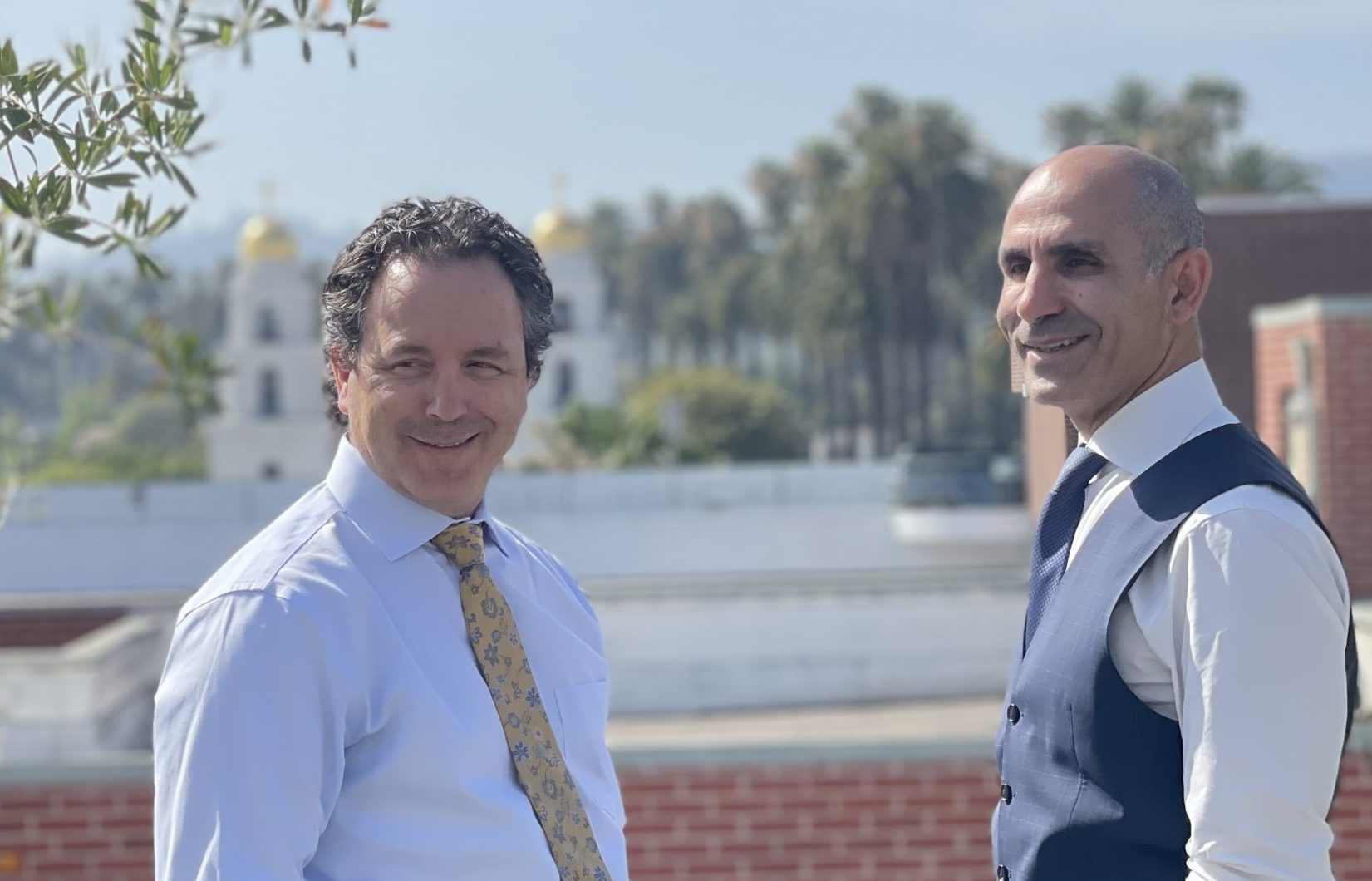
The difference between a fantastic result and the need for revision rhinoplasty can often come down to mere millimeters. At our practice, we have two double board-certified surgeons, Drs. Solieman and Litner, who work together during each step of your procedure – this is why we’re considered one of the best rhinoplasty centers in the world!
At PROFILES Beverly Hills, we consistently achieve unmatched, and satisfactory results for our patients.
Our commitment is to deliver long-lasting revision rhinoplasty results that you can be proud of. Results that restore surgical trust! We believe that you deserve the best nose for your facial profile, in both form and function. Many of our patients travel from out-of-town to correct their primary rhinoplasty done elsewhere.
We encourage you to browse our galleries and see for yourself the difference between our patients’ revision rhinoplasty before and after results. Each patient has a unique story, and our revision rhinoplasty procedure focuses on enhancing, and improving natural form and function. Our surgeries are uniquely tailored for each individual – there is no “cookie-cutter” procedure.
Here we illustrate a handful of the most common rhinoplasty mistakes and how we can fix them. There are a lot of delicate details that go into this, and cases such as these can take us many hours to perform. However, we dedicate the time necessary to get the best results possible in each case, because our ultimate goal is that your first rhinoplasty with PROFILES is also your last.
A scooped-out profile usually occurs after routine reduction rhinoplasty where there was a bump on the bridge that was shaved down too much. This can be particularly problematic when this occurs in men, as it is a feminizing feature.
Many rhinoplasty surgeons still prefer to make a bony bump smaller using a chisel or osteotome shown below on the left. Osteotomes are sharp instruments that cut through the bone at the desired level to lower the hump. This is an all-or-nothing tool where the bump is removed in one shot. The problem is one of judgment and execution. Sometimes the angle is not right or the surgeon thinks the bone is being taken down to a certain level only to discover that he or she misjudged. At PROFILES Beverly Hills, our expert surgeons prefer to use rasps to reduce a bump. Nasal rasps are essentially fine files, shown below on the right. These instruments can be used to slowly whittle or file down the bony bump. That way we can accomplish this three-dimensionally in a very careful and controlled way.
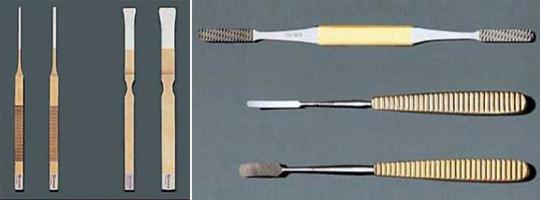
Moreover, it can be even easier to make a bump reduction mistake using a closed rhinoplasty approach (from inside the nostril) where this maneuver is being done under the cover of the nasal skin. In this case, it is difficult for the surgeon to see, so most of the work is done by ‘feel’. It takes a lot of experience to develop that ‘touch’ and to consistently get nasal hump reduction right.
In revision rhinoplasty, when the bone has been reduced too much, the nasal profile will look scooped and the bridge will look washed out and child-like from the front view. To fix this, we need to build the bony bridge back up again, most often with the patient’s own cartilage.
The photos below show the area of bone that was over-reduced, and what the bony profile should look like. The green shaded area is the area of the bridge to be built up.
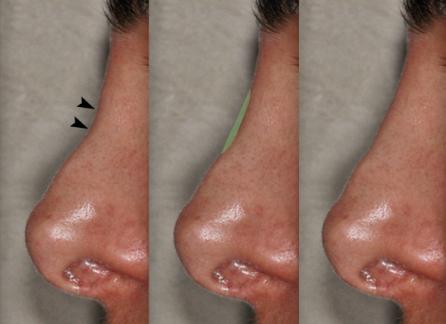
A pollybeak deformity refers to a nose in which the area just above the tip is too full. When it is very full, it can make the nose look down-turned, like a parrot’s beak, thus the name. Normally, there should be a little dip or depression just above your nasal tip that defines the transition from your bridge to your tip on profile. In a woman, that little dip is a feminizing feature. Your tip should be the most projecting point of your nose. Check out the photo below to see a pollybeak deformity indicated by the arrows.
The reason the nose can look like a parrot’s beak is that the area above the tip often becomes the part of your nose that sticks out or projects the most from your face. This is not the way it should be. Your tip should be the most projecting point of your nose. Check out the photo below to see a pollybeak deformity indicated by the arrows.
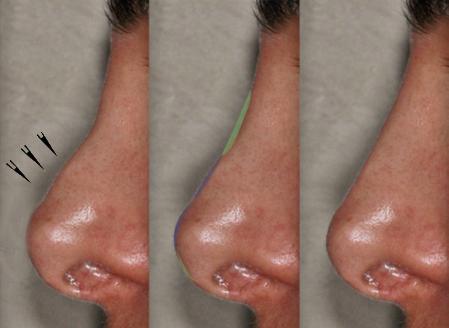
A few factors can cause this deformity, and they are all preventable.
Look at the image above to see the plan for fixing this pollybeak deformity. The green area is the area of the bridge that was built up in the last rhinoplasty. The blue shaded area shows the cartilage that has to be shaved down to correct it. Notice how the tip itself also has to be deprojected or brought in closer to the face.
When fixing this issue, if just the pollybeak was taken down, without the tip being brought in, it would look too high and too pointy. Although this is not an ideal look, it is something we also see a lot after first-time rhinoplasty procedures because tip correction is considerably difficult to perform. On the right, you can see how much more balanced the tip looks now. Note, that this is by no means a final image. In fact, the picture on the right does not show a completely improved appearance because we have not yet addressed the other problems with this nasal tip. It still looks pulled down and rounded, and the nostrils have to be addressed as well.
A frequent problem after an overaggressive rhinoplasty is a tip that becomes distorted and lacking in support. This usually happens when too much of the tip cartilages are removed in trying to narrow and refine the tip. Instead, you just end up with a tip that is unstable. We have lumped these 3 rhinoplasty surgery problems together because they often occur together after a rhinoplasty in which the tip cartilages collapsed.
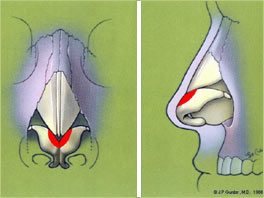
The rhinoplasty diagram above shows the area of the tip cartilages (in red) that is commonly removed during a rhinoplasty. This is considered a reasonable amount in most rhinoplasty patients, depending on their skin thickness. The key of course, is not to remove too much. Many rhinoplasty surgeons are very aggressive with these maneuvers and may take out most of this cartilage or slice right through it without repairing the edges. They often do this because the short-term changes can be very dramatic as you can turn a wide boxy tip into a very narrow one. However, the long-term results are usually devastating as the tip becomes progressively pinched and distorted over the years.
Furthermore, it is important to note that if too much cartilage is removed in this area, the tip can start to collapse. It can often look asymmetrical with the formation of bossae or little deformities and bumps in the cartilage that show through the skin. Also, the tip can start to rotate up too much. Unfortunately, this gives the nose an upturned and shortened “Ms. Piggy” appearance, which most patients are extremely unhappy with. This problem can be exaggerated when surgeons also remove the nasal spine (the bone at the bottom of the tip) and the bottom part of the septum. To figure out which part of your nose we are talking about, you can feel around just inside your nostrils. If you pinch the skin between your nostrils and advance your finger and thumb back a bit, you will feel a firm, yet wiggly piece of cartilage that is at the bottom part of the septum.
Maintaining the integrity of this anatomy is critical to ensuring good, strong results over time. If the above mistakes are made, the columella or structure separating the nostrils can appear to hang down too much, called a hanging columella. In addition, the rim of the nostrils can appear pulled back or retracted. Ideally, the distance between the edge of the nostril and the bottom edge of the columella should be no more than a few millimeters. Anything more creates a very unflattering look that resembles a snarl. Breathing can also be affected. These problems can be fixed but it takes a lot of expertise and complex techniques, including cartilage grafting.
Take a look at the imaged photos below to see the final step in improving the appearance of this nose with revision rhinoplasty surgery. The green shaded areas on the imaged photo are areas to be augmented or built up. The blue-shaded areas are to be shaved down. You can see that the columella is pulled up, the nostril rim is pulled down, and the angle between the tip and the upper lip is better. Notice that the tip still projects outward by almost the same amount, but it looks so much less dominant and heavy when these problems are corrected.
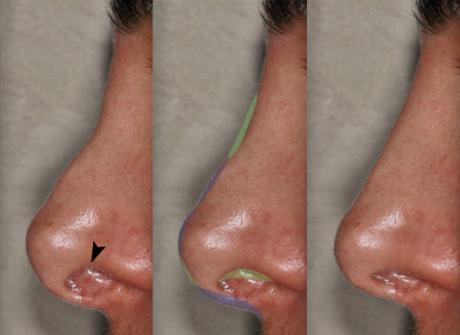
The rhinoplasty photos below show the original before revision rhinoplasty photo on the left, the imaged result in the middle, and the patient’s actual postoperative photo on the right. We make the revision rhinoplasty before and after imaged photo imperfect on purpose so that we do not over-sell the possible results.
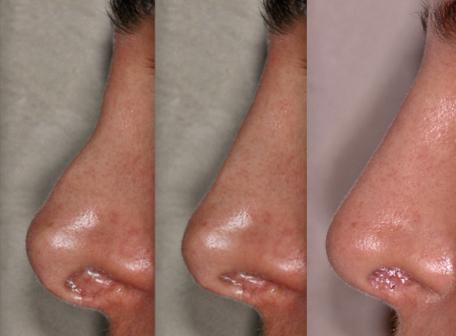
A frequent mistake seen after primary rhinoplasty surgery is a persistently over-projected tip. This means that the nasal tip still appears to stick out too far from your face. There are two reasons that this mistake is so common:
Below is an example of one of our revision rhinoplasty surgery patients that was unhappy with her tip projection, among other things. You can see that her tip looks too prominent. Her bridge is a little too sloped from her previous rhinoplasty, which makes her tip look even more pointy. The patient’s Beverly Hills PROFILES revision rhinoplasty included some augmentation of the bridge with tip deprojection, effectively restoring a more natural, attractive balance to her profile. Even better, because of the way we perform this procedure, her nose is now stronger than if she never had anything done.
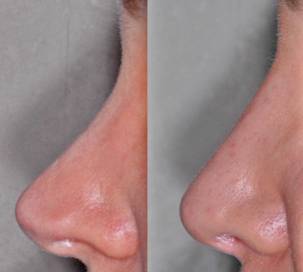
Think of the tip cartilages like a pair of wings. You can get an idea of what these look like from the rhinoplasty photos below. The cartilages are like a bent spring that holds the nostril’s shape, keeping it open to allow for normal breathing. In many poorly done rhinoplasty surgeries, this cartilage is aggressively cut or removed so that it loses this natural spring.

Over time, whatever cartilage is left starts to bend and twist under the weight of the skin. As the cartilage twists on itself, the weak points at the ‘joints’ of this cartilage can start to form bumps or knuckles, called bossae, that are very noticeable through the skin. Many rhinoplasty surgeons treat these bossae by going back and trimming them, weakening the cartilage even more. This is not a good long-term solution. Check out the diagram below to see what we mean.
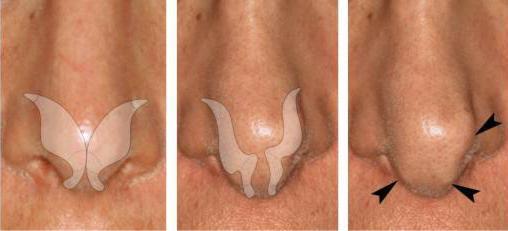
The Beverly Hills PROFILES revision rhinoplasty experts know that the tip cartilages must be reconstructed in order to restore their natural strength and resilience while improving the cosmetic appearance of the tip. The revision rhinoplasty surgery photos below show a patient treated at PROFILES. The patient had her tip bossae treated, as well as other post-rhinoplasty concerns that are highlighted in the next few sections.
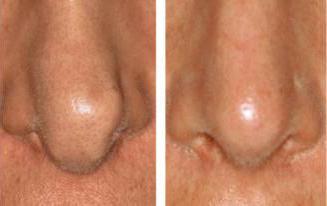
The nasal valve is a term used to describe the narrowest part of the nose internally. This is the area that determines if someone feels normal or obstructed breathing through the nose. When this area is overly narrowed and blocked, we call it a nasal valve collapse.
There are two types of nasal valve collapses. The collapse of the tip cartilages described above can cause external valve collapse where the blockage is just past the nostril. However, when most rhinoplasty surgeons discuss valve collapse, they are talking about internal valve collapse. This occurs when the upper lateral cartilages in the middle of the nose have been too narrowed. Take a look at the below diagram to see where these are. This problem happens when a nasal bump is taken down too much and when the cartilages themselves are shortened or not reattached during a rhinoplasty.
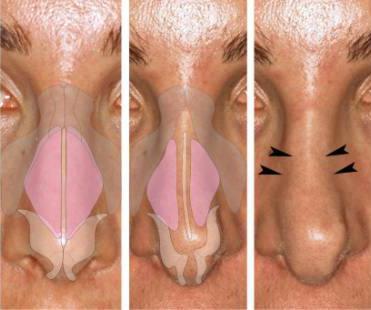
Nasal valve collapse issues seem to occur more often after a closed rhinoplasty, because most surgeons detach these cartilages without repairing and reattaching them at the end of the procedure. When the natural cartilage supports have been lost, they simply fall inwards and collapse. The result is poor breathing and two visible cosmetic deformities. One is called an ‘inverted V deformity’. That is because the collapsed area where these cartilages attach to the nasal bones looks like an upside-down letter V. Take a look at the photos below to see an ‘inverted V deformity’.
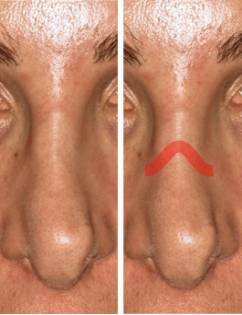
The second visible cosmetic deformity is when the middle part of the bridge starts to look very pinched. This issue is common after primary rhinoplasty.
The revision rhinoplasty experts at Beverly Hills PROFILES fix a pinched bridge using extended spreader grafts among other techniques.
The nasal bones are not so much like a pyramid, but more like an arched-covered bridge or tunnel. When a bump is made smaller, the top of the bones is shaved or cut shorter to reduce the bump. This leaves an opening in the roof of the bridge. That’s one of the reasons we have to cut the base of the bones during rhinoplasty surgery (called osteotomies). We perform osteotomies in order to push the bones inward towards each other so that this opening can be closed.
If the opening is not closed properly, we call the resulting problem an ‘open roof’ deformity. The photos below give you a sense of what this rhinoplasty problem looks like. When you have an open roof deformity, the middle part of the bridge will look and feel unnaturally flat. The edges of the bones are separated and can be seen and felt as a prominent bump at the side edge of the bridge.
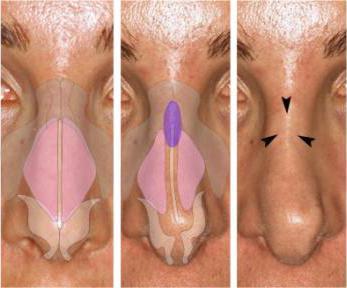
To repair an ‘open roof’ deformity, the bones need to be brought back together. However, sometimes the bones have been so shortened and whittled away that it is impossible to bring them together without pinching the top of the nose completely. In this situation, it is necessary to rebuild the roof with grafts. Whatever the extent of your rhinoplasty concerns, the PROFILES surgeons are well-versed in tailoring your procedure to address your individual issues.
A twist in the nose can happen anywhere from the nasal bones to the middle third of the nose and down to the tip. Getting a nose completely and perfectly straight is one of the hardest things to do in rhinoplasty, and is especially hard in revision rhinoplasty. That is why you need to see an experienced rhinoplasty specialist like our revision rhinoplasty specialists at Beverly Hills PROFILES in Los Angeles.
A frequent cause of a twisted nose is crooked nasal bones. This can result when a pre-existing crooked bridge simply was not corrected properly, or when poorly performed osteotomies caused the bones to shift. If the cartilage of the mid-nose or tip is twisted, sometimes it can be corrected by re-suspending or stabilizing the cartilage with sutures. This includes repairing the normal connections between anatomical parts that are often lost during prior surgery. It is important to note that careful planning and execution of each maneuver goes a long way in preventing these problems.
Furthermore, more often than not, we find that during revision rhinoplasty many of these normal structures have been damaged or removed in the primary rhinoplasty done elsewhere, causing the lower part of the nose to buckle and warp. Sadly, this is often beyond simple repair. In these cases, grafts of cartilage taken from your septum (if available), your ear, or rib (which is rarely done), are needed to rebuild the lost tissues and reconfigure their normal connections and supports.
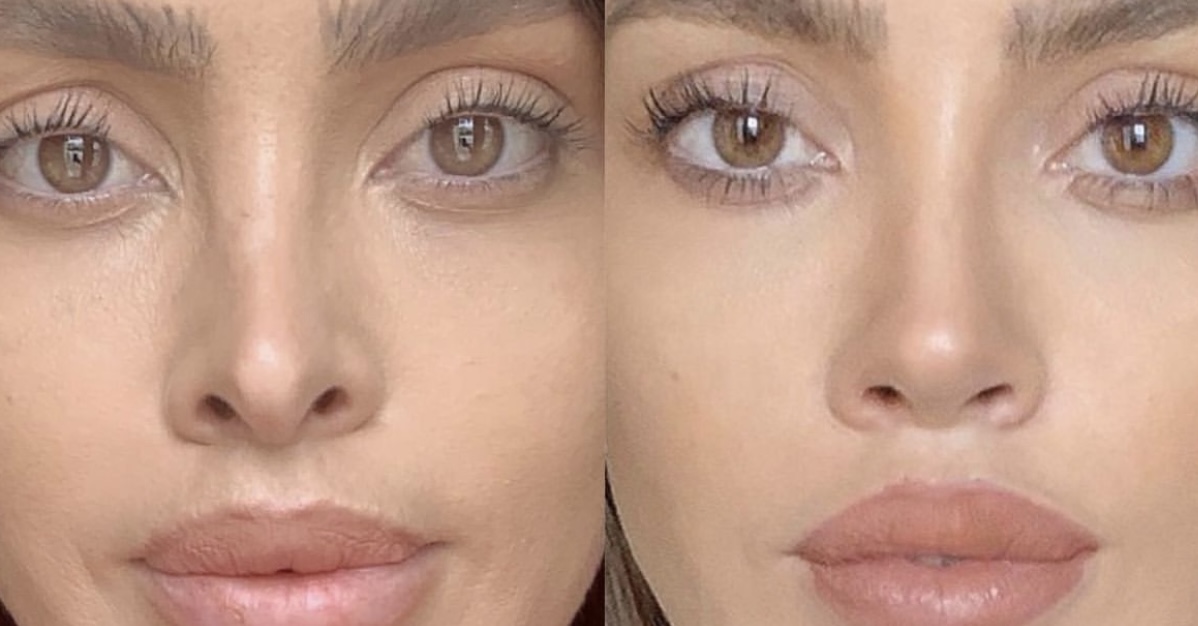
Oftentimes, Drs. Solieman and Litner find that their Iranian, Middle Eastern and Mediterranean patients have an overall larger nose, with either a straight bridge or a large hump. In these patients, the nasal tip is also typically large. Sometimes, Iranian and Middle Eastern patients have noses that are generally more droopy and lacking in adequate tip support compared to the average Caucasian nose. These noses require a different approach to achieve the beautiful results patients want.
Drs. Solieman and Litner will discuss the importance of skin thickness and impress upon you the benefits and difficulties that arise due to the heavy, thick skin often found in patients of Mediterranean and Middle Eastern descent. Additionally, they will tell you why they are able to achieve the natural, beautiful nose you want without causing the scooped-out or pinched look that is all too frequently seen.
Over the years, we have found that many of our African American patients who present for rhinoplasty feel that their nose is too wide, “too big,” and undefined for their faces. Therefore, one can imagine that there is often some confusion when we explain that augmentation rhinoplasty is often needed in order to make their noses look smaller.
Another way of understanding this is to see that in order to correct a nose that is too wide and too short, it is important to build up and add to the tip structure in order to not only provide adequate support but also to give lasting tip definition and refinement. The result is a thinner-looking, more refined nose.
Click here to learn more and read our blog post: I am African American and am considering rhinoplasty. Is your rhinoplasty technique different for me?
A low nasal bridge is probably the most common surgical indication for rhinoplasty in our Asian patients. However, unlike many other surgeons who use unnatural silicone implants, we utilize your own natural cartilage to build up the bridge and give the tip a more meaningful definition. The result is a natural look that lasts.
Click here to learn more.
As would be expected with any ethnic population, we have found that there is a continuum of nasal features in our Hispanic patients instead of distinct types. At Beverly Hills PROFILES, rather than trying to categorize various subgroups, we focus on your individual characteristics and goals. In general, we have found that our Hispanic patients’ facial and nasal characteristics can be differentiated from our Caucasian patients in the following ways:
It is important to work with surgeons who will take the time to understand what you are trying to achieve and who are comfortable dealing with different ethnic populations. We take these differences in anatomic and structural components into consideration when planning your surgery and explaining what can be accomplished.
During your consultation, we will work together to define what your aesthetic goals are, by using computer imaging. Based on your desires and your individual anatomy, we will then devise a surgical plan which is best suited to achieve your individual goals.
The size, shape and function of your nose can significantly impact your appearance, confidence and quality of life. It is the most defining characteristic of the face, therefore it is important to work with an experienced board-certified plastic surgeon who understands the impact of skin type, ethnic background, and age as key influencing factors in revision rhinoplasty preparation.
Our double board-certified surgeons, Drs. Litner and Solieman can only confirm whether you are a suitable candidate for revision rhinoplasty during consultation. Even though being in good health, a non-smoker with no pre-existing medical conditions that may adversely affect surgery or the healing process, and having realistic expectations may positively contribute to your candidacy for surgery.
Like other cosmetic procedures, there are potential risks and temporary side effects that come with revision rhinoplasty surgery. These include:
Drs. Litner and Solieman assess each patient, learn about their goals, and discuss the potential risks and possible side effects prior to revision rhinoplasty surgery in order to set the right expectations.
Because it takes six to twelve months for all the swelling to recede, you may have to wait up to a year to have revision rhinoplasty. However, if you are uncomfortable with your nose or have functional problems, Drs. Solieman and Litner can assess your case to determine the best course of action.
At PROFILES, Drs. Litner and Solieman conduct revision rhinoplasty surgeries regularly. Patients come from different states and all over the world after having problems with their previous rhinoplasty work. However, once they work with our double-board certified plastic surgeons they often achieve their cosmetic goals. Dr. Solieman and Litner want your revision rhinoplasty with them to be your last.
Swelling may take up to twelve months to completely recede. However, there are many cases where a bad rhinoplasty may result in breathing problems, other functional issues, and visible deformities. These patients may be candidates for surgery after six months. It is best to consult with Drs. Litner and Solieman to find the best alternative.
The price of revision rhinoplasty depends on your location and the plastic surgeon’s experience. If you want to get an accurate estimate, the best thing to do is consult with a double board-certified plastic surgeon in your area.
Inflammation is a normal part of the healing process after revision rhinoplasty. Although most swelling recedes in the first few weeks, it may take up to 12 months for it to go down completely. In order to see the final outcome of your first rhinoplasty, you may have to wait up to a year.
Shaping Contours In Elegance And Style
Our AAAHC-accredited facility meets the highest standard of care and is designed for your comfort and safety. Our environment reflects an eye for detail that delivers beautiful and satisfying results!

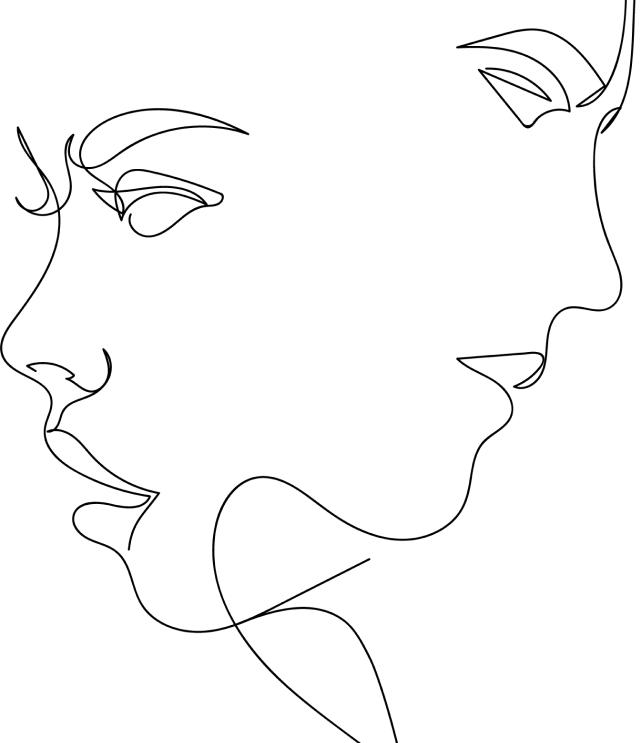
ASK US ANY QUESTION
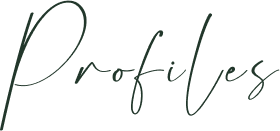
Sign Up For Our Newsletter
to Receive Special Offers!